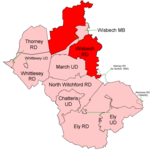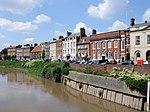Clarkson Memorial

The Clarkson Memorial in Wisbech, Isle of Ely, Cambridgeshire, England commemorates Thomas Clarkson (1760–1846), a central figure in the campaign against the slave trade in the British empire, and a former native of Wisbech. It was erected in 1880–1881 and is a Grade II* listed building.The memorial consists of a statue mounted on a high platform. Above this rises a canopy, in the form of a spire. The whole structure is 68 feet (20.6 m) high. On three of the four sides are carved bas-reliefs, representing William Wilberforce and Granville Sharp, both prominent figures in the campaign against the slave trade, and a manacled slave in a beseeching attitude. The fourth side bears an inscription to the memory of Clarkson.
Excerpt from the Wikipedia article Clarkson Memorial (License: CC BY-SA 3.0, Authors, Images).Clarkson Memorial
Fabianinkatu, Helsinki Kaisaniemi (Eteläinen suurpiiri)
Geographical coordinates (GPS) Address Nearby Places Show on map
Geographical coordinates (GPS)
| Latitude | Longitude |
|---|---|
| N 52.66469 ° | E 0.15841 ° |
Address
Helsingin pörssi
Fabianinkatu 14
00130 Helsinki, Kaisaniemi (Eteläinen suurpiiri)
Finnland
Open on Google Maps









